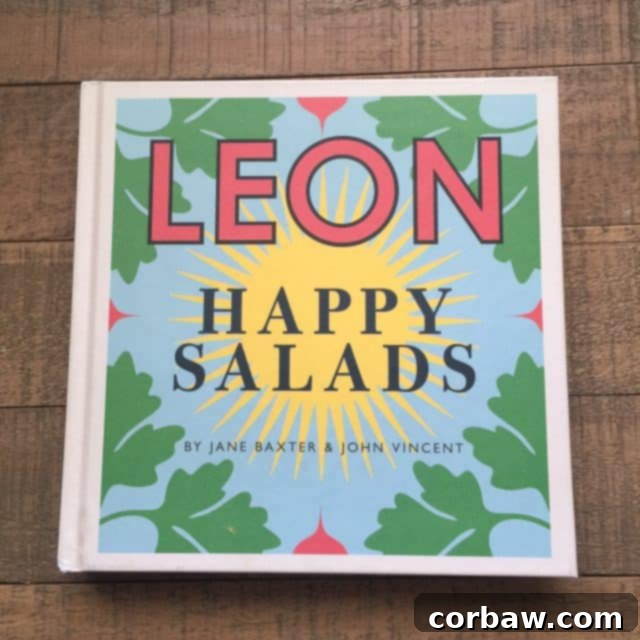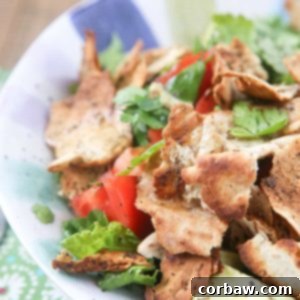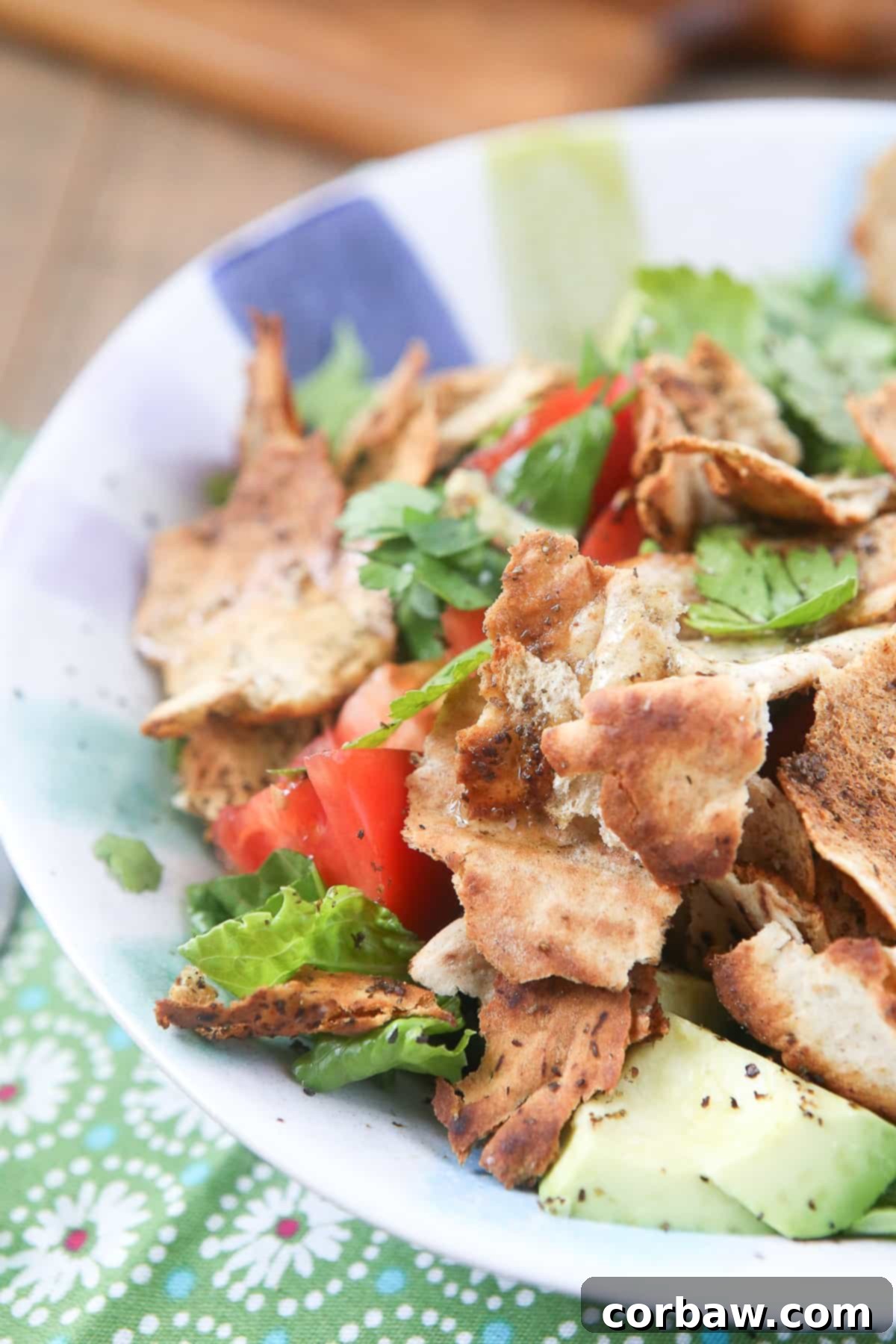Homemade Lebanese Fattoush Salad: A Fresh & Crunchy Delight for Any Table
You will absolutely adore this Lebanese-inspired Fattoush Salad, a vibrant celebration of fresh garden vegetables, fragrant herbs, and perfectly toasted pita pieces, all brought together with a zesty lemon and olive oil dressing. It’s a culinary journey that promises both health and unparalleled flavor in every bite.

Discovering Fattoush Salad felt like unearthing a culinary treasure. It combined everything I love in a meal: a medley of crisp, fresh vegetables, a vibrant burst of aromatic herbs, and most importantly, that irresistible crunch. The seasoned, toasted pita pieces scattered throughout this salad are a game-changer. For me, a salad truly isn’t complete without a satisfying crunch – it’s a textural element I simply can’t do without. While I have a soft spot for traditional croutons, I often look for healthier alternatives like nuts, and ever since I encountered this incredible Middle Eastern salad, toasted whole wheat pita has become my absolute favorite go-to. I particularly recommend the Joseph’s brand for its excellent texture and flavor.
My rendition of Lebanese Fattoush Salad, while deeply inspired by traditional flavors, does take a slight detour from the most stringent authentic recipes. Most traditional Fattoush recipes prominently feature sumac, a dark red spice known for its distinct tangy, lemony flavor. Although I didn’t have sumac readily available when developing this recipe, I opted for za’atar. Za’atar is a versatile and aromatic Middle Eastern spice blend that often includes sumac, along with roasted sesame seeds, dried thyme, and oregano, giving it a complex, herbaceous, and tangy profile that works beautifully in this dish. Regardless of whether it’s perfectly traditional or not, this particular salad has firmly established itself as one of my all-time favorites. The za’atar spice I use comes highly recommended by my dear friend Liz, a recommendation I’ve cherished for years.
The beauty of Fattoush lies not only in its fresh ingredients but also in its captivating textures. Just behold those perfectly toasted pita pieces – golden, crisp, and ready to soak up the vibrant dressing and add a delightful snap to every forkful. This crunchy element is what elevates Fattoush from a simple vegetable salad to an experience.

Why Fattoush Salad Deserves a Spot on Your Table
One of the most compelling reasons I adore this salad so immensely is its incredible simplicity, particularly when it comes to the dressing. A humble yet potent combination of fresh lemon juice and good quality olive oil, perhaps with a generous sprinkle of za’atar, is all it takes to elevate these garden-fresh ingredients to extraordinary heights. This minimalist approach allows the natural flavors of each vegetable and herb to shine through, creating a truly refreshing and invigorating dish. The bright acidity of the lemon cuts through the richness of the olive oil, while the za’atar adds an earthy, tangy, and slightly nutty dimension that is simply divine. It’s a testament to how the freshest ingredients, treated with respect and dressed simply, can create something truly spectacular.

My Culinary Inspiration: LEON Happy Salads
The inspiration to create this particular Fattoush Salad struck me last week after browsing one of my latest cookbook acquisitions, LEON Happy Salads. I stumbled upon this fantastic series of cookbooks last year and quickly added another title to my collection. I can genuinely say I absolutely adore them. The philosophy behind the LEON series – focusing on wholesome, delicious, and easy-to-make dishes that bring joy – perfectly resonates with my cooking style. While I didn’t meticulously follow their Fattoush recipe, I used it as a springboard, adapting it to the ingredients I had readily available in my kitchen at the time. This approach of using what you have on hand is one of the joys of cooking, allowing for creativity and making delicious meals accessible without a trip to the grocery store. This particular cookbook, “LEON Happy Salads,” is seriously one of the cutest and most inspiring culinary guides I own, packed with both classic and wonderfully creative salad recipes that are sure to spark joy in any home cook.

Exploring the Essence of Fattoush: A Culinary Journey
Fattoush is more than just a salad; it’s a staple of Levantine cuisine, originating from the fertile lands of Lebanon, Syria, and Palestine. Traditionally, it’s a dish born out of necessity and resourcefulness, often utilizing day-old pita bread and the freshest seasonal vegetables available in home gardens. This humble beginning is precisely what gives Fattoush its enduring charm and popularity. It’s a true testament to simple ingredients coming together to create something spectacular.
The Key Components of a Perfect Fattoush
At its heart, Fattoush is a celebration of fresh produce. While variations exist, the core ingredients typically include:
- Romaine Lettuce: Provides a crisp, refreshing base.
- Cucumber: Diced or sliced, adding a cool and watery crunch.
- Tomatoes: Ripe and juicy, offering a sweet and acidic counterpoint.
- Green Onions (Scallions): For a mild, pungent kick.
- Fresh Parsley and Mint: Essential for their vibrant, herbaceous freshness and aromatic lift. These herbs are non-negotiable for the authentic Fattoush flavor.
- Radishes: Often included for their peppery bite and beautiful color, adding another layer of crunch.
- Bell Peppers: Sometimes added for extra color and sweetness.
The combination of these ingredients creates a symphony of textures and flavors – from the crisp lettuce and cucumber to the juicy tomatoes and aromatic herbs.
The Star of the Show: Toasted Pita
What truly sets Fattoush apart from other salads is the inclusion of toasted or fried pita bread. These crisp, seasoned pieces of pita are not just a garnish; they are an integral part of the salad’s identity. They provide that unparalleled crunch that I so dearly love, and as they sit in the dressing, they absorb some of the zesty liquid, becoming delightfully tender yet still retaining a pleasant chewiness. Preparing the pita is simple: you can bake it until golden and crisp, pan-fry it in a little olive oil, or even air-fry it for a healthier option. The key is to break it into bite-sized pieces and season it, often with za’atar or sumac, before toasting.
The Tangy Dressing: The Soul of Fattoush
The dressing for Fattoush is refreshingly simple yet incredibly potent. It typically consists of a generous amount of fresh lemon juice and high-quality extra virgin olive oil. This basic emulsion provides the perfect balance of acidity and richness. Traditional Fattoush dressing also often includes sumac, which enhances the lemony tang and adds a unique, slightly berry-like flavor. While my recipe uses za’atar for its similar acidic notes and complex herb blend, understanding the role of sumac is key to appreciating the traditional profile. A touch of garlic and a pinch of salt and pepper round out this exquisite dressing, making it bright, flavorful, and incredibly invigorating.
Health Benefits of a Mediterranean Marvel
Beyond its incredible taste, Fattoush is a nutritional powerhouse. It’s packed with fresh, raw vegetables, which provide a wealth of vitamins, minerals, and antioxidants. The olive oil contributes healthy monounsaturated fats, beneficial for heart health. The whole wheat pita, if chosen, adds fiber. It’s a fantastic way to increase your intake of plant-based foods, offering a satisfying and nutrient-dense meal that supports overall well-being. It’s light, yet surprisingly filling, making it an ideal choice for a healthy lunch or a vibrant side dish.
Tips for Crafting Your Best Fattoush Salad
To ensure your Fattoush Salad is nothing short of spectacular, here are a few expert tips:
- Freshness is Key: Always use the freshest possible vegetables and herbs. This is paramount for the vibrant flavors of Fattoush.
- Perfect Pita: Don’t overcrowd your skillet or baking sheet when toasting the pita. Ensure even browning and crispness. A sprinkle of za’atar before toasting adds incredible flavor.
- Dressing Harmony: Whisk your lemon juice and olive oil thoroughly to emulsify them. Taste and adjust the seasoning – a little more lemon or salt can make all the difference.
- Strategic Dressing: For the crispiest pita, add the dressing and pita just before serving. This prevents the pita from becoming soggy too quickly. If preparing in advance, keep the dressing and pita separate until ready to serve.
- Customization: Feel free to experiment! While the core ingredients are essential, you can add other seasonal vegetables like thinly sliced red onion, cherry tomatoes, or even a sprinkle of crumbled feta cheese for a salty kick. For added protein, grilled chicken or chickpeas make a wonderful addition.
Serving Suggestions for Fattoush Salad
Fattoush Salad is incredibly versatile and can be enjoyed in many ways:
- As a Side Dish: It pairs beautifully with grilled meats such as chicken kebabs, lamb kofta, or grilled fish.
- Light Main Course: Served on its own, it makes a wonderfully light and satisfying lunch, especially if you add some grilled halloumi or chickpeas.
- Potlucks and Picnics: Its fresh, vibrant flavors make it a crowd-pleaser at any gathering. Just remember to pack the dressing and pita separately!
I hope this weekend finds you in a mood for some delightful salad making! If you’re looking to explore more fresh and exciting recipes beyond this fabulous Fattoush, consider trying my Spinach Salad with Peaches and Gorgonzola for a sweet and savory delight, or my Tangy Mustard Broccoli Slaw with Mango for a burst of tropical flavor. And for those seeking a more substantial, meal-worthy salad, this Baked Chicken Greek Salad with Avocado looks absolutely incredible and is certainly on my list to try!
Print Recipe
Fattoush Salad Recipe
Yield: serves 2

Ingredients:
- 1 small pita bread (I use Joseph’s Pita for best results)
- 2 tablespoons olive oil (for frying pita)
- A pinch of za’atar (for seasoning pita)
- 1 head romaine lettuce heart, finely chopped
- 1/2 seedless cucumber, meticulously diced
- 2 green onions, thinly chopped
- A generous handful of fresh parsley, roughly chopped
- A handful of fresh mint leaves, roughly chopped
- Coarse salt and freshly ground pepper, to taste
- Juice of 1/2 to 1 whole lemon (adjust to your preferred tanginess)
- 2-3 tablespoons extra virgin olive oil (for dressing)
Directions:
- Begin by preparing your crunchy pita crisps. Heat 2 tablespoons of olive oil in a small skillet over medium heat. Break the pita bread into small, bite-sized pieces and add them to the hot skillet. Sprinkle generously with za’atar. Fry for approximately 2-4 minutes, turning the pieces occasionally, until they are beautifully browned and wonderfully crisp. Remove from skillet and set aside to cool slightly.
- In a large mixing bowl, combine all of your fresh salad ingredients: the chopped romaine lettuce heart, diced seedless cucumber, chopped green onions, fresh parsley, and fresh mint.
- Season the salad generously with coarse salt and freshly ground pepper. Squeeze the fresh lemon juice over the vegetables and drizzle with 2-3 tablespoons of extra virgin olive oil. Toss all ingredients gently until they are thoroughly combined and coated with the vibrant dressing.
- Divide the dressed salad mixture onto two plates. Just before serving, top each portion with the prepared pita crisps. Serve immediately and savor the delightful flavors and textures! Enjoy!
Recipe inspired and slightly adapted from LEON Happy Salads cookbook
Follow AggiesKitchen on Instagram and show us what recipes you are making from the blog! Use the hashtag #aggieskitchen – I’d love to see what you are cooking up!
